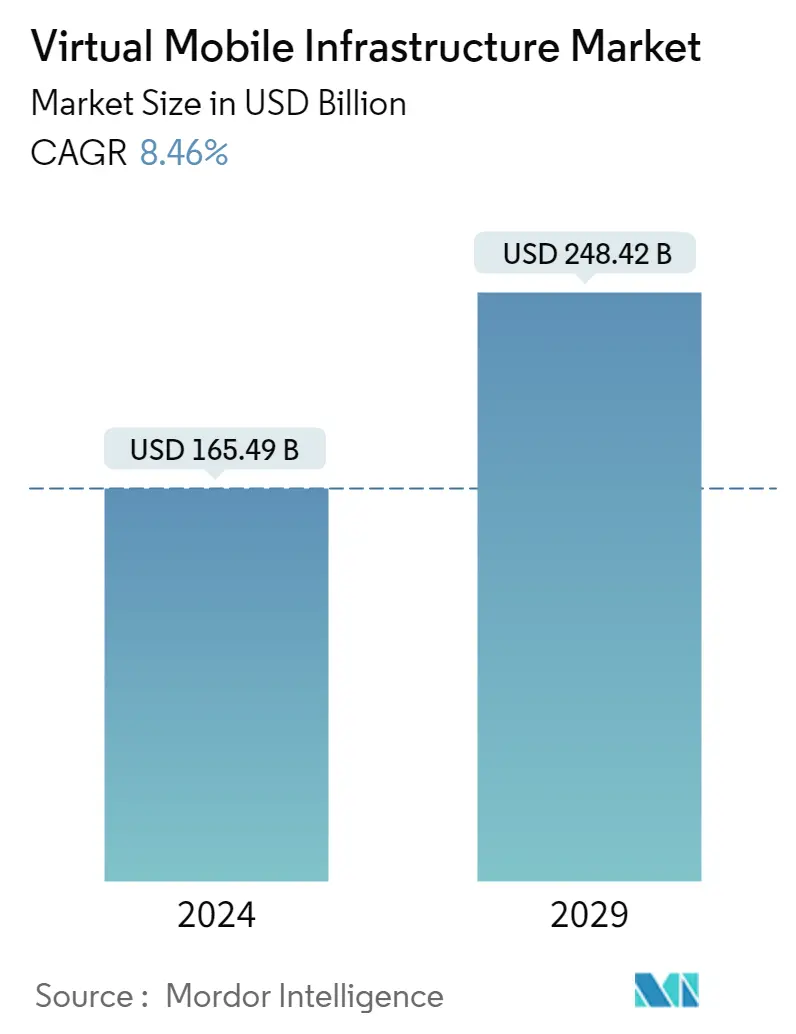Market Size of Virtual Mobile Infrastructure Industry

| Study Period | 2019 - 2029 |
| Market Size (2024) | USD 165.49 Billion |
| Market Size (2029) | USD 248.42 Billion |
| CAGR (2024 - 2029) | 8.46 % |
| Fastest Growing Market | Asia Pacific |
| Largest Market | North America |
Major Players
*Disclaimer: Major Players sorted in no particular order |
Virtual Mobile Infrastructure Market Analysis
The Virtual Mobile Infrastructure Market size is estimated at USD 165.49 billion in 2024, and is expected to reach USD 248.42 billion by 2029, growing at a CAGR of 8.46% during the forecast period (2024-2029).
The market for virtual mobile infrastructure is expected to expand in popularity due to the rapid rise of mobile phones around the world and the expansion of associated and smart frameworks. Furthermore, the virtual mobile infrastructure provides capabilities such as app network consumption, app blocking, and compliance reporting tools, all contributing to the market's growth.
- The rise in smartphone penetration is driving the virtual mobile infrastructure market. Enterprises can use virtual mobile infrastructure to host their mobile applications on servers and provide customizable remote access from any device. Deploying high-density virtual mobile infrastructure, the virtual mobile infrastructure helps to cut hardware and operating costs. Furthermore, many businesses focus on developing a single app that supports all types of mobile devices. Virtual mobile infrastructure provides advantages to companies, which is expected to drive the market.
- Electronic subscriber identification modules (e-SIMs) will provide out-of-the-box connection, making it available to all regional customers without needing particular installation, resulting in greater simplicity of use. NFV and SDN will offer new levels of rapid time-to-market (TTM) for new services and additional benefits, such as better managing wholesale data costs by lowering video traffic on the host network via traffic shaping on a virtualized packet gateway (PGW).
- In the context of the EU Roaming Regulation review, which would be extended until 2032, MVNO Europe, the group representing Mobile Virtual Network Operators active in the European Union, fought for reduced maximum wholesale rates and roaming access for IoT purposes. Although MVNO Europe welcomes the extension of the Roam-Like-At-Home regime until 2032, the association believes that more ambition could have been demonstrated by further lowering caps and expanding the Roam-Like-At-Home regime's application to IoT applications.
- To ensure business continuity, owing to the COVID-19 outbreak, business organizations, especially in highly affected countries, are allowing their employees to work from home (WFH). The increase in people working from home has led to increased demand for downloading, online video viewing, and communication through video conferencing, all leading to increased network traffic and data usage. Moreover, Vodafone UK has witnessed a 50% increase in internet traffic. Orange España is offering customers access to the free data bundles. Pre-paid customers can now access an additional 15 GB, while customers on postpaid plans can access an additional 30 GB.
- Moreover, security risks are also likely to concern the organizations. A third-party company may govern its work. To date, the third-party managers have handled services with utmost care. However, the threat of data breaches is always on, which also challenges market growth.The increasing activities of cyber criminals becoming successful at penetrating and moving laterally within the security perimeter are expected to increase privacy concerns. Organizations relying solely on on-premises firewalls and VPNs lack the visibility solution integration and agility to deliver timely end-to-end security coverage. As evidence, large-scale, multi-vector mega attacks are growing, wreaking havoc on organizations and individuals worldwide.
Virtual Mobile Infrastructure Industry Segmentation
A virtual mobile infrastructure is a service that allows a business to host its mobile applications or full operating systems on remote servers and provide personalized, remote access to these applications from any device. Employees no longer need to download mobile apps or save critical company information on their smartphones or tablets, which improves security. Furthermore, virtual mobile infrastructure allows administrators to centrally configure and deliver a number of mobile workspaces to their personnel in a simple and effective manner.
Virtual mobile infrastructure market is segmented by deployment type (on-premise, cloud), end-user verticals (BFSI, IT, telecommunication, healthcare, government), and geography (North America, Europe, Asia-Pacific, Latin America, Middle East, and Africa). The market sizes and forecasts are provided in terms of value (USD) for all the above segments.
| By Deployment Mode | |
| On-Premise | |
| Cloud |
| By End-user Vertical | |
| BFSi | |
| Healthcare | |
| Government and Defense | |
| Telecommunications and IT | |
| Manufacturing | |
| Other End-User Verticals |
| Geography | |
| North America | |
| Europe | |
| Asia-Pacific | |
| Latin America | |
| Middle East & Africa |
Virtual Mobile Infrastructure Market Size Summary
The virtual mobile infrastructure market is poised for significant growth, driven by the increasing penetration of smartphones and the need for efficient enterprise mobility solutions. This market is characterized by the ability to host mobile applications on servers, providing customizable remote access and reducing hardware and operating costs. The integration of technologies such as e-SIMs, NFV, and SDN is expected to enhance service delivery and manage data costs more effectively. The market's expansion is further supported by the growing demand for cloud-based services, which offer scalability, increased efficiency, and improved disaster recovery options. As businesses continue to modernize their IT infrastructure, the adoption of cloud technologies is becoming more prevalent, facilitating the development and deployment of new network services.
In North America, the virtual mobile infrastructure market is expected to hold a significant share due to advancements in technology and the widespread adoption of cloud services by enterprises. The region's focus on providing flexible workspaces and the evolution of work cultures are key factors contributing to market growth. The market is semi-consolidated, with players engaging in product innovation, mergers, and acquisitions to expand their offerings and geographic reach. Strategic partnerships, such as those between Vodafone Spain and Kyndryl, and Nokia's collaborations with T-Mobile and Red Hat, are enhancing service capabilities and supporting the deployment of advanced technologies like 5G. These developments, along with the increasing use of mobile cloud solutions, are expected to drive the market forward, offering new opportunities for cloud service providers and application developers.
Virtual Mobile Infrastructure Market Size - Table of Contents
-
1. MARKET INSIGHTS
-
1.1 Market Overview
-
1.2 Industry Value Chain Analysis
-
1.3 Industry Attractiveness - Porter's Five Forces Analysis
-
1.3.1 Threat of New Entrants
-
1.3.2 Bargaining Power of Buyers/Consumers
-
1.3.3 Bargaining Power of Suppliers
-
1.3.4 Threat of Substitute Products
-
1.3.5 Intensity of Competitive Rivalry
-
-
1.4 Assessment on the Impact of COVID-19 on the market
-
-
2. MARKET SEGMENTATION
-
2.1 By Deployment Mode
-
2.1.1 On-Premise
-
2.1.2 Cloud
-
-
2.2 By End-user Vertical
-
2.2.1 BFSi
-
2.2.2 Healthcare
-
2.2.3 Government and Defense
-
2.2.4 Telecommunications and IT
-
2.2.5 Manufacturing
-
2.2.6 Other End-User Verticals
-
-
2.3 Geography
-
2.3.1 North America
-
2.3.2 Europe
-
2.3.3 Asia-Pacific
-
2.3.4 Latin America
-
2.3.5 Middle East & Africa
-
-
Virtual Mobile Infrastructure Market Size FAQs
How big is the Virtual Mobile Infrastructure Market?
The Virtual Mobile Infrastructure Market size is expected to reach USD 165.49 billion in 2024 and grow at a CAGR of 8.46% to reach USD 248.42 billion by 2029.
What is the current Virtual Mobile Infrastructure Market size?
In 2024, the Virtual Mobile Infrastructure Market size is expected to reach USD 165.49 billion.

